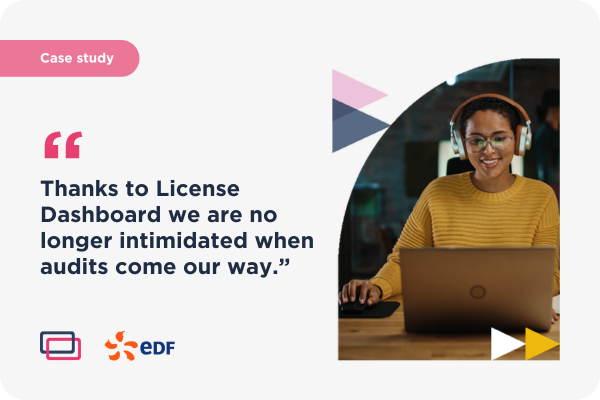It may be priority number one for the Software Asset Manager, but managing the IT estate effectively isn’t so high on the agenda for the rest of the organization. IT trends like BYOD, virtualization, and cloud migration can make the SAM Manager’s life hectic, but with a reported 68% chance of being audited inside the next 12 months, it only becomes more complex.
How, then, can SAM Managers build a financial case for software asset management, and convince the boardroom that as well as avoiding fines, it’s essential in optimizing spend?
What does it mean to argue the financial case for SAM?
The key business benefits of SAM are based on compliance, efficiency, and agility. Implementing an in-house SAM program can take months, or even years in some cases. For those organizations at the beginning of their SAM journey, it may seem like a simple enough process to reach a state of compliance, but the installation of technology, the training of staff, and the actual roll-out of a new SAM processes can take a big chunk of time away from day-to-day business activities.
Here lies the problem in building a financial case for SAM.
The IT department, or the SAM Manager, must build a persuasive business case for software asset management, that will not only convince the organization to take it on, but to take it seriously as an ongoing practice. They must show that the benefits of managing software licenses effectively will far outweigh any investment in time, money, and resource.
Why investing in SAM is important
Software asset management provides full control over the complicated risks involved in software license spend, and it allows the IT department to optimize software asset use. Full visibility of the software estate means that when a software vendor sends an audit request, not only is the IT department confident that they are compliant (therefore avoiding a hefty fine), they are in a position to prove it quickly and easily. Without SAM, time and resource must be allocated to gathering license and user data, which can take weeks, even months – and that’s a lot of time away from “business as usual”.
How to lay out SAM’s financial benefits
There are, essentially, six steps to a successful SAM strategy:
Step One: Learn the ins and outs of software agreement terms and the different licensing metrics
Step Two: Create a centralized software inventory for all existing software
Step Three: Reconcile license entitlement to software utilization
Step Four: Identify whether or not additional licensing needs to be purchased
Step Five: Create/review existing SAM policies
Step Six: Maintain the SAM process
We found that 73% of SAM Managers spend the bulk of their time on transactional license management tasks: steps one, two, and three. Rather than analyzing usage data, and turning software inventory into real business intelligence, SAM Managers are constantly playing catch-up to try and understand who is using what and how inside their ever-changing organization.
A software license management service outsources the periodic gathering and uploading of discovery and license entitlement data for more reliable usage and reconciliation results. The IT estate can be proactively managed to avoid over-deployment of both software and hardware, meaning the risk of non-compliance is vastly reduced, and unused license can be returned or re-issued.
If the IT department can communicate the financial gains to be made from SAM – by avoiding fines following a vendor audit, and by ceasing the purchase of unnecessary software licences – it becomes a top priority.
Who needs to understand the importance of SAM?
With the potential to shave up to 30% off software spend in the first year, the financial case for implementing a SAM program is a strong one. But, it’s with the interest of key stakeholders, and understanding from multiple departments in an organization, that SAM can grow and become a key component in business intelligence.
Getting IT on board should be easy. Gaining control of the entire IT estate, and knowing what’s deployed and where, and who’s using what will have a massive impact on how the department operates. It’ll help build effective processes and procedures for upgrading and releasing software, and it will simplify the way staff and IT work together in that respect.
Due to the fact that SAM offers full visibility of the IT estate, the Legal department will be far better equipped to deal with an audit request from a software vendor, with all documentation pertaining to license terms on hand.
If Procurement has better knowledge of software usage, they’re in a stronger position to negotiate contract renewals with software vendors. In an ever-changing organization, that is a valuable asset to have, and should that organization be migrating to the cloud, SAM can be of help too. Similarly, Organizational Management can engage in better budgeting and forecasting if the IT spend is readily available.
Even Human Resources benefits from SAM as they monitor staff compliance toward company policies and regulations, which includes the use of IT. SAM allows for a well-organized and well-optimised resource for employees’ assets as they come and go.
Where can SAM “sit” so it is accessible for all?
Organizations should share software usage monitoring information across business departments, optimizing the value of SAM data through accessible communications, and coherent reporting, resulting in meaningful actions. Sounds complicated, but it doesn’t have to be.
Rather than deploying multiple desktop applications, which can get confusing as well as time consuming, finding a SAM tool that offers up-to-date, real-time SAM data, gathered from multiple sources, through multiple discovery tools will provide an accurate snapshot of the full IT network. Impressive, but a potentially overwhelming amount of data!
License Dashboard Portal offers software usage monitoring with bespoke reporting capabilities. The dashboard comes with pre-defined reports, a fully customizable, role-specific dashboard, and granular filters that can be drilled down into and saved for future reporting purposes. Perfect for highlighting the metrics that matter to each department most.
Financial exposure is visualized, unused or dormant licenses are highlighted, and the risk of non-compliance is underlined. This data can all be exported, and so easily fed into department-specific reporting, which means it’s easy for each department to see ROI, while the SAM Manager manages risk and compliance.
When is the right time for SAM?
Implementing a SAM program can happen any time, but organizations should set aside some time to evaluate their current SAM maturity, and, as with any key business decision, outline what goals will be met by its implementation. This is the foundation when building a financial case for SAM.


























